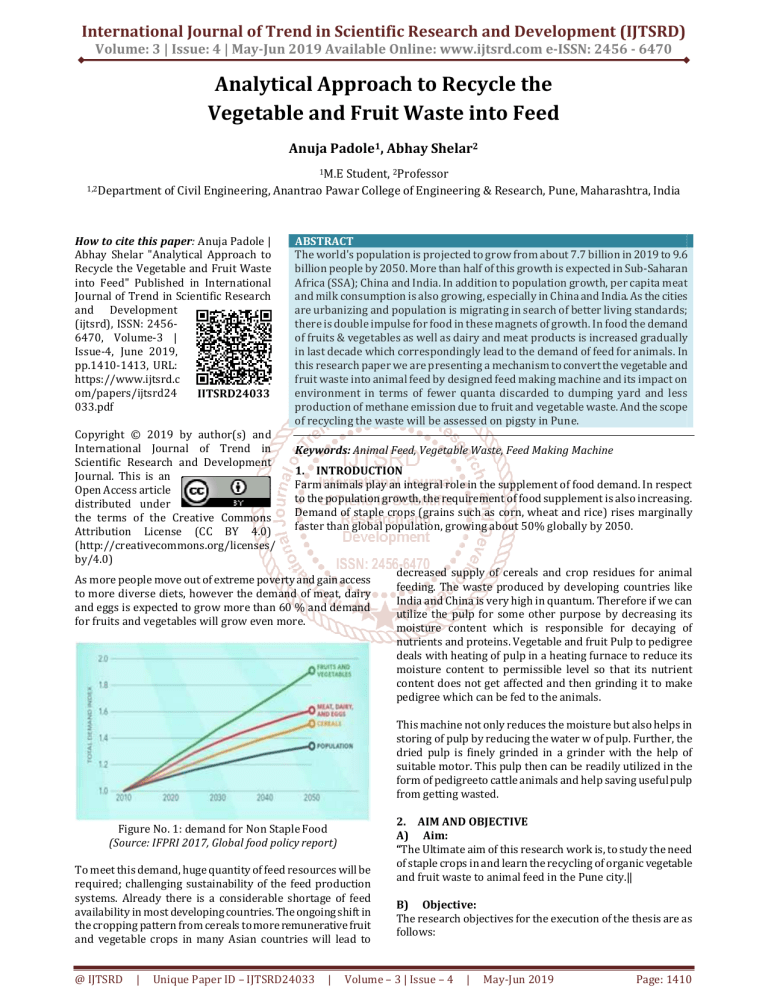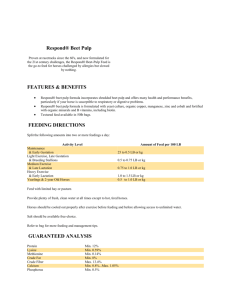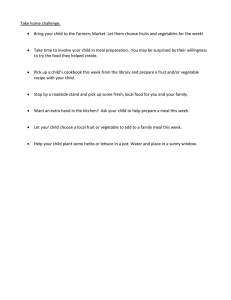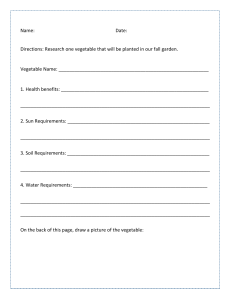
International Journal of Trend in Scientific Research and Development (IJTSRD) Volume: 3 | Issue: 4 | May-Jun 2019 Available Online: www.ijtsrd.com e-ISSN: 2456 - 6470 Analytical Approach to Recycle the Vegetable and Fruit Waste into Feed Anuja Padole1, Abhay Shelar2 1M.E Student, 2Professor 1,2Department of Civil Engineering, Anantrao Pawar College of Engineering & Research, Pune, Maharashtra, India How to cite this paper: Anuja Padole | Abhay Shelar "Analytical Approach to Recycle the Vegetable and Fruit Waste into Feed" Published in International Journal of Trend in Scientific Research and Development (ijtsrd), ISSN: 24566470, Volume-3 | Issue-4, June 2019, pp.1410-1413, URL: https://www.ijtsrd.c om/papers/ijtsrd24 IJTSRD24033 033.pdf Copyright © 2019 by author(s) and International Journal of Trend in Scientific Research and Development Journal. This is an Open Access article distributed under the terms of the Creative Commons Attribution License (CC BY 4.0) (http://creativecommons.org/licenses/ by/4.0) ABSTRACT The world's population is projected to grow from about 7.7 billion in 2019 to 9.6 billion people by 2050. More than half of this growth is expected in Sub-Saharan Africa (SSA); China and India. In addition to population growth, per capita meat and milk consumption is also growing, especially in China and India. As the cities are urbanizing and population is migrating in search of better living standards; there is double impulse for food in these magnets of growth. In food the demand of fruits & vegetables as well as dairy and meat products is increased gradually in last decade which correspondingly lead to the demand of feed for animals. In this research paper we are presenting a mechanism to convert the vegetable and fruit waste into animal feed by designed feed making machine and its impact on environment in terms of fewer quanta discarded to dumping yard and less production of methane emission due to fruit and vegetable waste. And the scope of recycling the waste will be assessed on pigsty in Pune. Keywords: Animal Feed, Vegetable Waste, Feed Making Machine 1. INTRODUCTION Farm animals play an integral role in the supplement of food demand. In respect to the population growth, the requirement of food supplement is also increasing. Demand of staple crops (grains such as corn, wheat and rice) rises marginally faster than global population, growing about 50% globally by 2050. As more people move out of extreme poverty and gain access to more diverse diets, however the demand of meat, dairy and eggs is expected to grow more than 60 % and demand for fruits and vegetables will grow even more. decreased supply of cereals and crop residues for animal feeding. The waste produced by developing countries like India and China is very high in quantum. Therefore if we can utilize the pulp for some other purpose by decreasing its moisture content which is responsible for decaying of nutrients and proteins. Vegetable and fruit Pulp to pedigree deals with heating of pulp in a heating furnace to reduce its moisture content to permissible level so that its nutrient content does not get affected and then grinding it to make pedigree which can be fed to the animals. This machine not only reduces the moisture but also helps in storing of pulp by reducing the water w of pulp. Further, the dried pulp is finely grinded in a grinder with the help of suitable motor. This pulp then can be readily utilized in the form of pedigreeto cattle animals and help saving useful pulp from getting wasted. Figure No. 1: demand for Non Staple Food (Source: IFPRI 2017, Global food policy report) To meet this demand, huge quantity of feed resources will be required; challenging sustainability of the feed production systems. Already there is a considerable shortage of feed availability in most developing countries. The ongoing shift in the cropping pattern from cereals to more remunerative fruit and vegetable crops in many Asian countries will lead to @ IJTSRD | Unique Paper ID – IJTSRD24033 | 2. AIM AND OBJECTIVE A) Aim: “The Ultimate aim of this research work is, to study the need of staple crops in and learn the recycling of organic vegetable and fruit waste to animal feed in the Pune city.‖ B) Objective: The research objectives for the execution of the thesis are as follows: Volume – 3 | Issue – 4 | May-Jun 2019 Page: 1410 International Journal of Trend in Scientific Research and Development (IJTSRD) @ www.ijtsrd.com eISSN: 2456-6470 1. To recycle vegetable and fruit market garbage into animal feed. 2. To curtail the cost of recycling and use of land for landfilling of MSW disposal by reusing it and generate revenue through it. 3. LITERATURE REVIEW Fruit and Vegetable Co-Products as Functional Feed Ingredients in Farm Animal Nutrition for Improved Product Quality In this research paper, author shows the evidence that fruit and vegetable processing co-products can be effectively used in farm animal nutrition as functional feed ingredients for the production of food products of improved quality. These ingredients comply with consumer requests for the production of ―clean,‖ ―natural‖ and ―eco/green‖ label food products. The main parameters affecting extensive application of fruit and vegetable processing by-/co-products as functional feed ingredients in livestock nutrition are related to animal factors, logistics, and commercial value. diverting it from disposal sites, and providing a source of income. Overall, publications from case studies and field research seem disproportionately underrepresented for all technologies. More unbiased, well-structuredand reproducible evidence from case studies at scale could foster the knowledge transfer to practitioners and enhance the exchange between academia, policy and practice. A Methodology for Sustainable Management of Food Waste On the bases of author study and analysis, as much as onethird of the food intentionally grown for human consumption is never consumed and is therefore wasted, with significant environmental, social and economic ramifications. An increasing number of publications in this area currently consider different aspects of this critical issue, and generally focus on proactive approaches to reduce food waste, or reactive solutions for more efficient waste management. Waste to worth: vegetable wastes as animal feed In this research paper author, the chemical composition, nutritional value and use of a number of vegetable wastes (VWs) and by-products such as baby corn, cabbage, carrot, cauliflower, cucumber, jackfruit, peas, potato, sweet corn (SC), tomato, and radish leaves, among others in ruminant and monogastric diets, are presented in this publication. Author finds that the major constraints in using these products as livestock feed are their highmoisture content and presence of contaminants, mainly pesticides and pesticide residues. This research paper takes a holistic approach with the aim of achieving a better understanding of the different types of food waste, and using this knowledge to support informed decisions for more sustainable management of food waste. With this aim, existing food waste categorizations are reviewed and their usefulness are analysed. Author used drying and ensiling for enhancing shelf life and making their incorporation in animal feeds easier. According to author, there is a need to monitor pesticide and pesticide residues, mycotoxins, heavy metals and ant nutritional factors before using vegetable products in animal diets. These resources are yet untapped and their efficient use will enlarge feed resource base, enhance feed availability and bring the wasted food back to human food chain. Design and Fabrication of Pedigree Making Machine In this research article, author focus on research of machine to convert waste into animal feed. The need is pretty well explained with author in the format of give example of drinking juice never made us realize that how much fruit pulp is getting wasted. If we can utilize that pulp for some other purpose by decreasing its moisture content which is responsible for decaying of things it would be of great benefit. Pulp to pedigree deals with heating of pulp to reduce its moisture content and then grinding it to make pedigree which can be fed to the animals. This machine not only reduces the moisture but also helps in storing of pulp. Further, the dried pulp is finely grinded. This pulp then can be readily utilized in the form of pedigree to cattleanimals and help saving useful pulp from getting wasted. Potential Utilization of Fruit and Vegetable Wastes for Food through Drying or Extraction Techniques According to author literature review to feed the current and next level of population and address the food security and the environmental issues, waste reduction and utilization food resources are the important strategies to be developed. The nutritional characterization of waste from fruits and vegetables suggest that most of these crop remains and byproducts can be utilized, recovered and converted into value added food products. Hence, value addition of these wastes through drying technology and extraction methods to dehydrated products and nutraceutical products, respectively could be an alternative market option for the food and the associated industries. This in turn can create more economic opportunities; enhance the social and environmental value for the producers, processors and consumers. Treatment technologies for urban solid bio waste to create value products: a review with focus on low- and middle income settings As per research paper, treatment of bio waste, the predominant waste fraction in low- and middle- income settings, offers public health, environmental and economic benefits by converting waste into a hygienic product, @ IJTSRD | Unique Paper ID – IJTSRD24033 | Author presented a systematic methodology to identify types of food waste through a nine-stage categorization is used in conjunction with a version of the waste hierarchy applied to food products. Fruit and Vegetable Waste: Bioactive Compounds, Their Extraction, and Possible Utilization According to author, fruits and vegetables are the most utilized commodities among all horticultural crops. They are consumed raw, minimally processed, as well as processed, due to their nutrients and health-promoting compounds. With the growing population and changing diet habits, the production and processing of horticultural crops, especially fruits and vegetables, have increased very significantly to fulfil the increasing demands. The processing operations of fruits and vegetables produce significant wastes or by-products, which constitute about 25% to 30% of a whole commodity group. This review describes the types and nature of the waste that originates from fruits and vegetables, the bioactive components in the waste, their extraction techniques, and the potential utilization of the obtained bioactive compounds. Volume – 3 | Issue – 4 | May-Jun 2019 Page: 1411 International Journal of Trend in Scientific Research and Development (IJTSRD) @ www.ijtsrd.com eISSN: 2456-6470 4. METHODOLOGY The overall methodology for carrying out for the Research work is as follows For the fan of 245 cfm discharge, 160 mm diameter fan is used. Air velocity (v) = Air discharge/ area of duct = 5.86 m/s ii) Convective H. T. Coefficient Of Air (h) Air properties at 130 0C Dynamic viscosity = 2.33 * 10-5 Kg/ m*sec Density = 0.8646 Kg/m3 Prandtl number = 0.6955 (Prandtl number - A dimensionless parameter used in calculations of heat transfer between a moving fluid and a solid body) Thermal conductivity= 0.03393 W/ m*k Characteristic length= 0.0152 m (Calculated by assuming flat plate of length 1 meter & width (π * 0.160) meter) So, from above data Reynolds number Re = 3305.22 Figure No. 2: Overall Methodology for Carrying Out Research Work 5. DESIGN AND DEVELOPMENT OF FEED MAKING MACHINE A) Design Calculation of Machine Parts The machine is designed for a capacity of 4 kg fruit and vegetable pulp, so while designing maximum capacity 4 Kg are taken for calculation. So Maximum pulp (Mp) = 4 kg Amount of moisture content in peels considered as (x) - 80 % = 0.8 For calculation purpose specific heat of orange peels has considered (cps) - 3.81 KJ/Kg. Specific heat of air (cpg) - 1.005 KJ/Kg. Latent heat of water (hw) - 2257 KJ/Kg. Initial temperature of peels (T3) - 30 0C. Final temperature of peels (T4) - 90 0C. Initial temperature of air = 33 0C. Correlation used is, Nu = 0.683*(Re) 0.466 * (Pr) (1/3) We know that Nu= (h * characteristic length) / Dynamic viscosity So finally, h. t. Coefficient of air, h= 58.95 W/ m2K iii) Electric Heater Selection 0 Heater is required to heat the suppled air up to 130 C from 0 the atmospheric temperature of about 33 C. So, Wattage W= h * Area of heater * (130 – 33) = 58.95 * π* 0.016*1* (130 - 33) W= 179.61 Watt = 180 iv) Minimum power of electric heater must be greater than 180 Watts. Furnace Capacity 4 kg of peels having volume approximately 0.02 cubic m So volume of furnace is for compatibility is taken as 1 ft * 1 ft * 1 ft V= 1* 1 * 1 cubic feet = 0.028316 cubic meter B) CONSTRUCTION AND WORKING OF MACHINE Temperature of air at inlet of compartment (T1) - 130 0C Temperature of compartment at outlet (T2) - 50 0C. i) Mass Flow Rate of Air Required (Ma) By Energy balance equation Ma * cpg (T1 – T2) = Mp * cps (T3 – T4) + (xhw) Ma * 1.005 * (130 – 50)= 4 * 3.81 * (90 – 30) + (4 * 0.8 * 2257) Ma= 101.203 Kg/ hr = 0.0281 Kg/sec Finally mass flow rate of air 0.1 Kg/ sec selected. Density of air at 130 degree= ρ = 0.8646 Kg/ m3 Volume flow rate of air = Mass flow rate / density of air = 0.1 / 0.8646 = 0.11565 m3/sec = 244.94 CFM ≈ 245 CFM (cubic feet per minute) So exhaust fan of minimum discharge 245 cfm must be selected. @ IJTSRD | Unique Paper ID – IJTSRD24033 | Figure No. 3: Pilot Model of Feed Making Machine Fig shows the simple setup for the pedigree making machine. It consists of the furnace made up of MS sheets. There is a lid for the manually feeding of fruit and the vegetable waste. Volume – 3 | Issue – 4 | May-Jun 2019 Page: 1412 International Journal of Trend in Scientific Research and Development (IJTSRD) @ www.ijtsrd.com eISSN: 2456-6470 Inside the furnace compartment a heater coil and temperature measuring device are installed which is not visible in the figure. Heating coil is used to heat the pulp and the temperature measuring device is used to monitor the temperature inside the furnace. An Exhaust fan is installed near the furnace compartment in downward side so as to increase the heat transfer rate by inducing hot air to the furnace. Exhaust Fan is driven by the DC motor. The furnace is followed by the grinder; the household grinder is installed near the furnace. The transfer of pulp from furnace to the grinder will take place manually and the grinder which operates on the mechanical linkage. To collect the feed in powder form a collecting vessel is used at the bottom. Figure No. 4: Flow Diagram of Working Mechanism of Feed Making Machine C) SPECIFICATIONS OF COMPONENTS Table No. 1: Specifications of Components Used in Feed Making Machine Sr. No. Component Unit of Measure ment Quantity Specificatio n 1 Heating Coil Nos. 1 750 Watt, AC, 1m Length 2 Exhaust Fan Nos. 1 Diameter 160mm, 250CFM 3 Household Grinder Nos. 1 Ac 230V, 40Watt. 4 PVC Elbow Nos. 2 110mm Diameter 5 Switch Nos. 1 3/2 Switch 6 Hopper Nos. 1 (1 x 1 x 1) feet CONCLUSION The designed and fabricated feed making machine is Pedigree making machine for animal feed, in which approximately 4kg of Fruit and vegetables pulp can be used at a time. This machine has limited use up to some extent of commercial purpose. The capacity of the same machine can be easily modified for the use of large scale commercial purpose. REFERENCE [1] Pfaltzgraff, L.A.; Cooper, E.C.; Budarin, V.; Clark, J.H. Food waste biomass: A resource for high-value chemicals. Green Chem. 2013, 15, 307– 314. [2] Santana-Méridas, O.; González-Coloma, A.; SánchezVioque, R. Agricultural residues as a source of bioactive natural products. Phytochem. Rev. 2012, 11, 447–466. [3] Waldron, K. Waste minimization, management and coproduct recovery in food processing: An introduction. In Handbook of Waste Management and Co-Product Recovery in Food Processing; Waldron, K., Ed.; Woodhead Publishing Limited: Cambridge, UK, 2007; Volume 1, pp. 3–20. [4] Elferink, E.V.; Nonhebel, S.; Moll, H.C. Feeding livestock food residue and the consequences for the environmental impact of meat. J. Clean. Prod. 2008, 16, 1227–1233. @ IJTSRD | Unique Paper ID – IJTSRD24033 | [5] Panouillé, M.; Ralet, M.C.; Bonnin, E.; Thibault, J.F. Recovery and reuse of trimmings and pulps from fruit and vegetable processing. In Handbook of Waste Management and Co-Product Recovery in Food Processing; Waldron, K., Ed.; Woodhead Publishing Limited: Cambridge, UK, 2007; Volume 1, pp. 417–447. [6] European Commission. Innovating for sustainable growth: A bioeconomy for Europe. COM (212) 60 final. Available online: [7] Laufenberg, G.; Kunz, B.; Nystroem, M. Transformation of vegetable waste into value added products: (A) the upgrading concept; (B) practical implementations. Bioresour. Technol. 2003, 87, 167–198. [8] Mirabella, N.; Castellani, V.; Sala, S. Current options for the valorization of food manufacturing waste: A review. J. Clean. Prod. 2014, 65, 28–41. [9] Burt, S. Essential oils: Their antibacterial properties and potential applications in foods—A review. Int. J. Food Microbiol. 2004, 94, 223–253. [10] Grunent, K.G. Food quality and safety: Consumer perception and demand. Eur. Rev. Agric. Econ. 2005, 32, 369–391. [11] Joppen, L. Taking out the chemistry. Food Eng. Ingred. 2006, 31, 38–41. Volume – 3 | Issue – 4 | May-Jun 2019 Page: 1413




